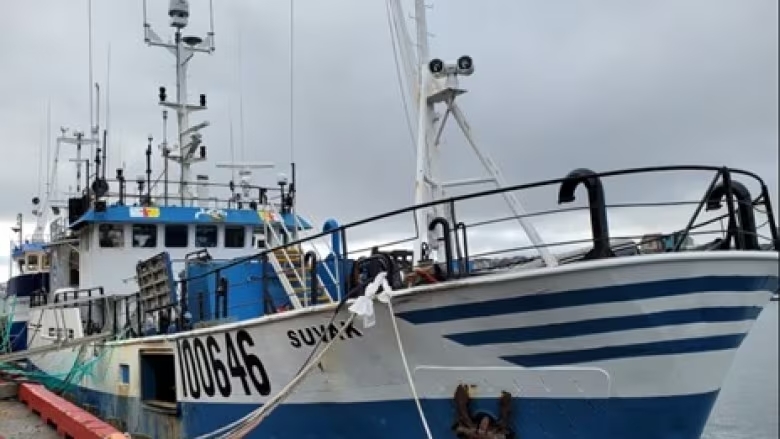Report says lack of safety contributed to worker’s death on Nunavut fishing vessel

Man working on Iqaluit-based vessel Suvak died in 2021 after going overboard in Davis Strait.
The death of a worker who went overboard on a fishing vessel in Nunavut in 2021 highlights gaps in safety management on that boat and similar vessels in the territories, according to an investigation report released Thursday.
The report was done by the Transportation Safety Board of Canada (TSB), which looks into marine, rail and air incidents but does not assign fault or determine criminal liability.
It looked at the circumstances around the death of a crew member who died in August 2021 while working aboard the Iqaluit-based fishing vessel Suvak.
The worker was pulled overboard when his arm became entangled in a buoy line. He was recovered from the water and later pronounced dead, the report states.
The worker and another crew member aboard the Suvak had been awake for over 21 consecutive hours before the incident, the investigation found.
It happened around 3 a.m. when the workers were setting gill nets in the Davis Strait, about 220 kilometres offshore from Qikiqtarjuaq, Nunavut. The two were nearly at the end of their two-week work rotation when the incident took place.
“The two crew members … were experiencing sleep-related fatigue from a combination of acute and chronic sleep disruption, continuous wakefulness, and circadian rhythm disruptions, which reduced their cognitive abilities, including their ability to remain vigilant against risks,” the report states.
The crew member who died on the Suvak was also smaller in stature, the investigation report says, and he had adapted a way to pick up the coils of the buoy line to keep them in place.
“In combination with mental and physical fatigue, this adaptation led to his arm becoming entangled in the buoy line,” the report states.
TSB investigators highlighted several issues in connection with the incident, including an absence of fatigue management plans and risk assessments. They also called for the implementation of procedures, equipment and drills for responding to entanglement situations on board.
Kathy Fox, the Transportation Safety Board’s chair, told CBC that the governments of Canada and Nunavut, and the operators of fishing vessels, are responsible for worker safety.
We want to see more proactive action of the part of regulators, operators and crew members to reduce the risk so that crew members come home safely. – Kathy Fox, Transportation Safety Board
Fox said commercial fishing is “one of the most dangerous occupations in this country.”
“We lose, on average, 11 fish harvesters a year. Many of the issues are recurring,” she said.
Following the investigation, the Arctic Fishery Alliance, which manages the Suvak, made several changes. Those included providing crew members with special rope-cutting knives on their belts.
Safety deficiencies in fishing industry
Commercial fishing has been on the TSB watch list since 2010, which identifies key safety issues around transportation in Canada.
“Every year, the same safety deficiencies on board fishing vessels continue to put at risk the lives of thousands of Canadian fish harvesters and the livelihoods of their families and communities,” the report says.
The TSB says there is a lack of sufficient oversight of occupational health and safety on fishing vessels registered in the territories.
‘[The board recommends] the Department of Transport, in collaboration with the Department of Employment and Social Development and the territorial governments, review the occupational health and safety oversight of fishing vessels registered in the territories to ensure effective workplace safety oversight,” the report states.
According to the TSB, the Workers’ Safety and Compensation Commission of Nunavut and the Northwest Territories considered fishing vessels to be under Transport Canada’s jurisdiction, while Transport Canada considered health and safety inspections to be outside its jurisdiction.
This meant no inspections were done on the Suvak or nine other fishing vessels in Nunavut, the report said.
The report also noted that the same was true for the 24 registered fishing vessels in the Northwest Territories, and four registered in Yukon.
Related stories from around the North :
Canada : Canada’s largest fishing vessel will be ready for 2024, says Baffin Fisheries CEO, CBC news
Finland : Finnish Sámi activists win fishing rights case, Yle News
Russia : Russian fishing boat capsizes in Barents Sea leaving 17 people missing, Eye on the Arctic
USA : Search resumes for the missing after landslide in Alaska fishing community, The Associated Press



